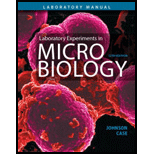
Concept explainers
To write:
The effectiveness of autoclaving, boiling, microwaving and dry heating.
Introduction:
Sterilization is the killing or removal of all the living microorganisms, including the bacterial spores that are highly resistant. It is usually carried out by autoclaving or moist heating, boiling, microwaving and dry heating as the effective methods and consists of maximum exposure to steam as well.
Explanation of Solution
Autoclaving is a moist heat sterilization method that uses high-pressure steam. This process works by the concept that the boiling point of water or steam increases when it is under pressure. The steam inside the autoclave attacks the microorganisms and kills them. Boiling is a simple method of heating water to a high temperature of 100°C, kills most of the pathogenic microorganisms.
Microwaving is a thermal process and most of the processed foods are heat treated to kill the microorganisms. It does not kill the microorganisms completely. Dry heating kills or removes all the microorganisms, including bacterial spores. It requires a longer time for exposure as well as higher temperatures as well. Its higher temperature kills the microorganisms using a destructive oxidation method. Moist heating or autoclaving is the most effective way of killing all the microorganisms, because of its ability to penetrate microbial cells. It is followed by dry heating and then, boiling is effective as it produces heat more thoroughly and flashover can be avoided as compared to microwaving.
Thus, the effectiveness of moist heating or autoclaving is the highest, followed by dry heating that requires longer time and the temperature, then boiling with temperature of 100°C and lastly, microwaving which is a thermal process.
Want to see more full solutions like this?
Chapter 22 Solutions
Pearson eText for Laboratory Experiments in Microbiology -- Instant Access (Pearson+)
- What is behavioral adaptarrow_forward22. Which of the following mutant proteins is expected to have a dominant negative effect when over- expressed in normal cells? a. mutant PI3-kinase that lacks the SH2 domain but retains the kinase function b. mutant Grb2 protein that cannot bind to RTK c. mutant RTK that lacks the extracellular domain d. mutant PDK that has the PH domain but lost the kinase function e. all of the abovearrow_forwardWhat is the label ?arrow_forward
- Can you described the image? Can you explain the question as well their answer and how to get to an answer to an problem like this?arrow_forwardglg 112 mid unit assignment Identifying melting processesarrow_forwardGive only the mode of inheritance consistent with all three pedigrees and only two reasons that support this, nothing more, (it shouldn't take too long)arrow_forward
- Oarrow_forwardDescribe the principle of homeostasis.arrow_forwardExplain how the hormones of the glands listed below travel around the body to target organs and tissues : Pituitary gland Hypothalamus Thyroid Parathyroid Adrenal Pineal Pancreas(islets of langerhans) Gonads (testes and ovaries) Placentaarrow_forward
 Principles Of Radiographic Imaging: An Art And A ...Health & NutritionISBN:9781337711067Author:Richard R. Carlton, Arlene M. Adler, Vesna BalacPublisher:Cengage Learning
Principles Of Radiographic Imaging: An Art And A ...Health & NutritionISBN:9781337711067Author:Richard R. Carlton, Arlene M. Adler, Vesna BalacPublisher:Cengage Learning- Surgical Tech For Surgical Tech Pos CareHealth & NutritionISBN:9781337648868Author:AssociationPublisher:CengageBasic Clinical Lab Competencies for Respiratory C...NursingISBN:9781285244662Author:WhitePublisher:Cengage





